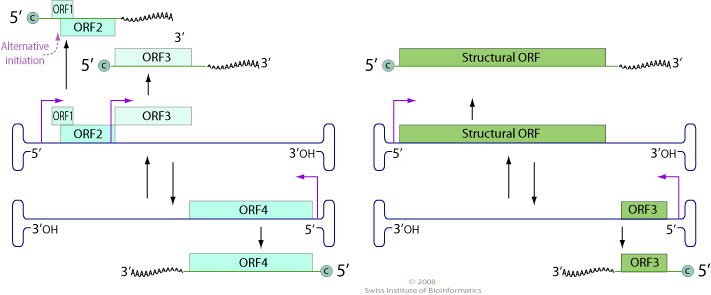|
Cossaviricota
''Cossaviricota'' is a phylum of viruses. Classes The following classes are recognized: * '' Mouviricetes'' * ''Papovaviricetes ''Papovaviricetes'' is a class of viruses. The class shares the name of an abolished family, ''Papovaviridae'', which was split in 1999 into the two families ''Papillomaviridae'' and ''Polyomaviridae''. The class was established in 2019 and takes ...'' * '' Quintoviricetes'' References Viruses {{Virus-stub ... [...More Info...] [...Related Items...] OR: [Wikipedia] [Google] [Baidu] |
Quintoviricetes
Parvoviruses are a family of animal viruses that constitute the family ''Parvoviridae''. They have linear, single-stranded DNA (ssDNA) genomes that typically contain two genes encoding for a replication initiator protein, called NS1, and the protein the viral capsid is made of. The coding portion of the genome is flanked by telomeres at each end that form into hairpin loops that are important during replication. Parvovirus virions are small compared to most viruses, at 23–28 nanometers in diameter, and contain the genome enclosed in an icosahedral capsid that has a rugged surface. Parvoviruses enter a host cell by endocytosis, travelling to the nucleus where they wait until the cell enters its replication stage. At that point, the genome is uncoated and the coding portion is replicated. Viral messenger RNA (mRNA) is then transcribed and translated, resulting in NS1 initiating replication. During replication, the hairpins repeatedly unfold, are replicated, and refold to chang ... [...More Info...] [...Related Items...] OR: [Wikipedia] [Google] [Baidu] |
Virus
A virus is a submicroscopic infectious agent that replicates only inside the living cells of an organism. Viruses infect all life forms, from animals and plants to microorganisms, including bacteria and archaea. Since Dmitri Ivanovsky's 1892 article describing a non-bacterial pathogen infecting tobacco plants and the discovery of the tobacco mosaic virus by Martinus Beijerinck in 1898,Dimmock p. 4 more than 9,000 virus species have been described in detail of the millions of types of viruses in the environment. Viruses are found in almost every ecosystem on Earth and are the most numerous type of biological entity. The study of viruses is known as virology, a subspeciality of microbiology. When infected, a host cell is often forced to rapidly produce thousands of copies of the original virus. When not inside an infected cell or in the process of infecting a cell, viruses exist in the form of independent particles, or ''virions'', consisting of (i) the genetic material, i. ... [...More Info...] [...Related Items...] OR: [Wikipedia] [Google] [Baidu] |
Mouviricetes
''Bidensovirus'' is a genus of single stranded DNA viruses that infect invertebrates. The species in this genus were originally classified in the family '' Parvoviridae'' (subfamily ''Densovirinae'') but were moved to a new genus because of significant differences in the genomes.Virus Taxonomy: Ninth Report of the International Committee on Taxonomy of Viruses (2011) Taxonomy There is one species in this genus currently recognised: ''Bombyx mori bidensovirus''. Host As the name suggests this virus infects '' Bombyx mori'', the silkworm. Virology The virions are icosahedral, non enveloped and ~25 nanometers in diameter. They contain two structural proteins. The genome is bipartite, unique among ssDNA viruses, with two linear segments of ~6 and 6.5 kilobases (kb). These segments and the complementary strands are that are packaged separately giving rise to 4 different types of full particles. Both segments have an ambisense organization, coding for a structural protein in o ... [...More Info...] [...Related Items...] OR: [Wikipedia] [Google] [Baidu] |
Papovaviricetes
''Papovaviricetes'' is a class of viruses. The class shares the name of an abolished family, ''Papovaviridae'', which was split in 1999 into the two families ''Papillomaviridae'' and ''Polyomaviridae''. The class was established in 2019 and takes its name from the former family. Orders The following orders are recognized: * ''Sepolyvirales'' * ''Zurhausenvirales'' See also * Bandicoot papillomatosis carcinomatosis virus Bandicoot papillomatosis carcinomatosis virus is a circular double-stranded DNA virus isolated from bandicoots (''Perameles bougainville''). The genome has features similar to viruses in the families ''Papillomaviridae'' and the ''Polyomaviridae ... References Viruses {{Virus-stub ... [...More Info...] [...Related Items...] OR: [Wikipedia] [Google] [Baidu] |

